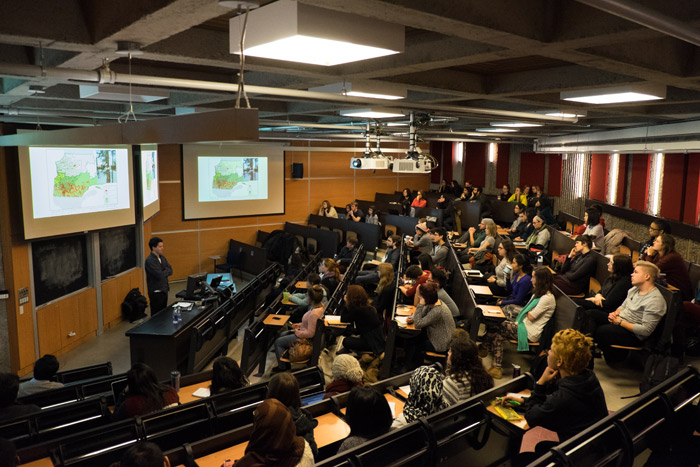On Jan 22, the Comparative Healthcare Systems Program (CHSP), a student initiative dedicated to study of public health and comparative healthcare, hosted a public health symposium on the theme of indigenous health. Speakers addressed food security and healthcare services in northern Canada, noting the alarming situations in indigenous communities in the north.
According to Associate Professor of wildlife biology at McGill University, Murray Humphries, people living in the north often suffer from food insecurity.
“Almost 10 per cent of the [Canadian] population [has] moderate to severe levels of food insecurity,” he explained. “In Nunavut, it’s 36 per cent. More than one in three households are in this state.”
Humphries shared his recent personal experience with limited food options during his time working on a research project in Old Crow, Yukon.
“[There’s] only one place to purchase food,” he said. “Ten dollars for [a carton of] milk, $26 for [a jug of orange] juice, $16 for apples.”
Katarina Kunhert – U1 Sustainability, Science, and Society – lived in Inuvik, Northwest Territories when she was a toddler.
“In Inuvik in the 1990s, a box of mandarin oranges would cost $25 […] and it’s half rotten because it took so long to get there,” she recalled. “In Tuktoyatuk, which is an island a little bit further north, […] the same box of oranges cost $50, but now three-quarters of it is rotten [.…] If you were to buy the same box of oranges in Edmonton, then it would cost $6 and they’d all be perfect.”
According to Humphries, official statistics often do not reflect regional disparities between the northern and southern regions of provinces. The south is populated mostly by settlers, while the north is populated mostly by indigenous people.
“The higher rates [in the north] are often concealed by the provincial averages,” Humphries explained. “Given that the statistics are particularly alarming for Nunavut, then probably it’s equally as bad in portions of Northwest Territories, Yukon, and especially the northern prairie provinces, northern Ontario, and northern Quebec.”
Currently, the Canadian federal government recognizes three main categories of Aboriginal Peoples: Inuit, First Nations, and Metis. About 1.4 million people in Canada identify as Aboriginal.
John Pringle, nurse and epidemiologist with a PhD in public health and bioethics explained that health is not only about physical well-being, and that food security is not only about having enough food.
“[There are] appalling rates of diabetes, suicides, substance abuse in these [indigenous] communities,” he said. “In [the] Northern Stores [grocery chain], it’s ridiculous how expensive food is; but you know, pop and chips are always on sale.”
According to Humphries, one of the leading causes of food insecurity in the north is difficult transportation.
“Railways and roads in Canada […] are surprisingly restricted to the south,” Humphries said. “You see vast portions of Canada that are outside the realm of roads or real access. Some [parts] of [the north] are served by winter roads. These are the vast regions of the country that don’t get all-season access.”
Food procurement and retail in the north are currently oligopolized by a small number of corporations. Without competition, food prices stay high.
“The connection between food pricing and transportation costs is complicated,” Humphries said. “In the north, Northern Stores is affiliated with the Hudson’s Bay [….] However, northern residents are already protesting and organizing initiatives to curtail the monopoly [….] A lot of people in the north […] formed Facebook groups like ‘Feed My Family,’ protesting […] the cost of northern foods. Many communities are looking to generate their own cooperatives and food supplies, trying to put the costs down.”
Humphries also drew attention to the lack of health services for people living in northern parts of Canada.
“In Old Crow, there’s a nursing station,” he said. “The doctor comes once a month. Most people who require hospitalization will go to Whitehorse, Vancouver, or Edmonton.”
Pringle, who worked at a nursing station serving First Nations communities in the Great Lakes District in Manitoba during the early 2000s, pointed out that services for Aboriginal Peoples are not only scarce, but also severely underfunded and short-handed.
“We should have [had] five nurses in that station, but we had two,” Pringle said. “We worked clinics all day and we were on call for emergencies all night, so there were times that we just never slept for days [….] We were getting burnt out. The nurse that worked with me actually died of a heart attack.”
Pringle remarked that the nurses working in these stations are often inexperienced.
“[When] I just graduated from nursing [school …] I called Health Canada and they paid for me to […] work for at least a year in a First Nations nursing station,” he said. “Of course, when I leave [the Great Lakes District,] they’ll stick some naïve, young nurse to take over for me.”
At the end of the symposium, Pringle encouraged students in healthcare-related programs to join in the course of improving Canadian health services.
“Issues like these are seldom discussed in the academic world,” he said. “But really, we lose the radical reasons [for why] we want to be health professionals in the first place [.…] Keep the fire burning.”









Pingback: Starvation in Canada: Food insecurity in the north More effort needed to improve indigenous health, speakers say by Ashley Kong Jan 26, 2016 | saintandrewstwinflame